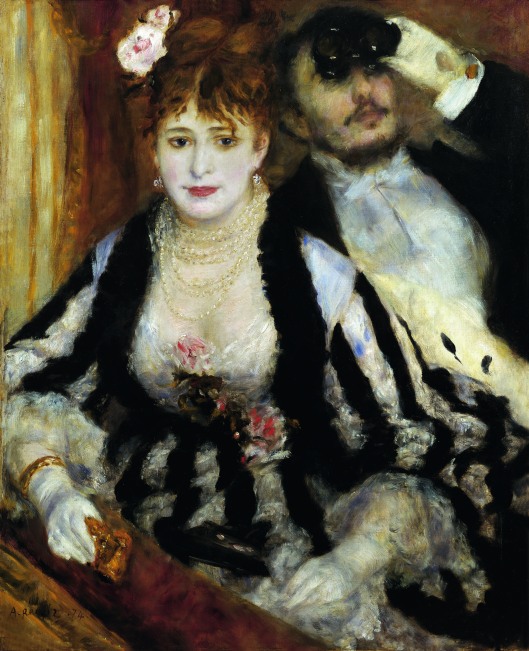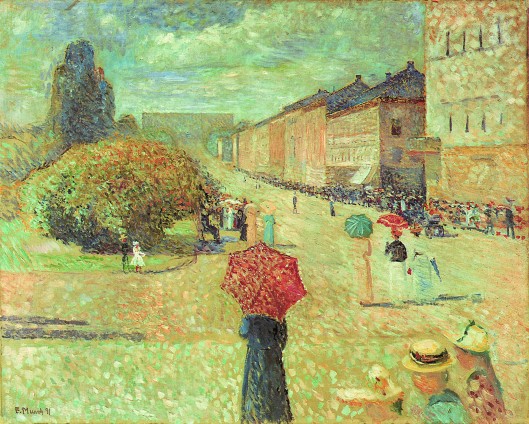 Reviewed by P.P.O. Kane
Reviewed by P.P.O. Kane
Impressionism
Edited by Ingo F. Walther
Taschen, 2013
ISBN: 9783836548939
This excellent book is in two parts. Peter H. Feist is the author of part one, whose focus is on Impressionism in France. All the artists you would expect to see are here, along with others who are not so welll known but equally worthy of attention. The paintings of Caillebotte in particular reward close study. Feist writes in great detail about the approach and character of each artist, the art scene in Paris and in particular the institution of the salon, the practice of open-air painting and the influence of photography (though this is perhaps not stressed enough: see Aaron Scharf’s Art and Photography for a corrective). You learn a lot and get to see many masterpieces, like this intriguing interior by Renoir:
 Various authors, including Feist and the editor Ingo F. Walther, contribute to part two, which looks at Impressionism in Europe and Britain, America and Canada. This offers more of an overview if not exactly a whizz-through, with many fine artists to discover (Levitan, Denis, Serov, Evenepoel, Lega…) but a few notable omissions. There are chapters on Impressionism in Germany and various central and Eastern European countries, but no chapter specifically on Austria. Curious, because many of the countries that are covered were actually part of the Austro-Hungarian Empire at the time. A (post)impressionist phase is clearly discernible in Klimt’s work (e.g. that poppy field) as well as other Austrian artists, above all Tina Blau. In fact Antonin Proust, Manet’s great champion, specifically singled out one of Blau’s paintings for praise at an exhibition in Vienna in 1882, as Julie Johnson recounts in The Memory Factory.
Various authors, including Feist and the editor Ingo F. Walther, contribute to part two, which looks at Impressionism in Europe and Britain, America and Canada. This offers more of an overview if not exactly a whizz-through, with many fine artists to discover (Levitan, Denis, Serov, Evenepoel, Lega…) but a few notable omissions. There are chapters on Impressionism in Germany and various central and Eastern European countries, but no chapter specifically on Austria. Curious, because many of the countries that are covered were actually part of the Austro-Hungarian Empire at the time. A (post)impressionist phase is clearly discernible in Klimt’s work (e.g. that poppy field) as well as other Austrian artists, above all Tina Blau. In fact Antonin Proust, Manet’s great champion, specifically singled out one of Blau’s paintings for praise at an exhibition in Vienna in 1882, as Julie Johnson recounts in The Memory Factory.
There is another omission worth mentioning – maybe minor when the movement is considered in the round, granted – and that is Adolphe Valette. Vallette settled in Manchester and painted around about, perhaps taking his inspiration from Monet who once said (in earnest, I think, he wasn’t much of a joker) that he went to London for the fog. In Manchester Vallette found myriad miasma, but survived. He later became, incidentally, a tutor of L.S. Lowry.
These two parts make up the bulk of the book and are followed by a directory, compiled by Walther, of those who have influenced or contributed to Impressionism in some way. This consists, in the main, of biographical sketches and career summaries of the artists and of writers, patrons and others.
What you are left with at the end is the realisation of how very different these artists were, despite being part of the same broad movement. Another realisation is that pretty much all of the artists of the period (the book covers the years 1860-1920) went through a (post)impressionist phase of some sort. This includes artists as dissimilar as Munch, Mondrian and Klimt: the first two are represented in the book, Klimt (as noted above) is not. Here is Munch as Impressionist:
 Artists like Munch had to meet Impressionism to move beyond it; it was a game-changer, in that sense. Rather extreme and more difficult to defend is Virginia Woolf’s claim that ‘in or about December 1910 [the date of a postimpressionist exhibition in London], human nature changed.’ She might be going a bit too far there.
Artists like Munch had to meet Impressionism to move beyond it; it was a game-changer, in that sense. Rather extreme and more difficult to defend is Virginia Woolf’s claim that ‘in or about December 1910 [the date of a postimpressionist exhibition in London], human nature changed.’ She might be going a bit too far there.
This is a glorious book, packed with information and insight and luxuriously detailed reproductions, which you’ll undoubtedly want to dip into always. It overflows with rapturous beauty.
There is a selection of Vallette’s paintings at Manchester Art Gallery, as well as a smattering of other Impressionist works, but in Britain the best galleries for Impressionism remain the National Gallery and especially the Courtauld Gallery, which has a number of fine Cezannes.
About the reviewer: P.P.O. Kane lives and works in Manchester, England. He welcomes responses to his reviews and you can reach him at ludic@europe.com